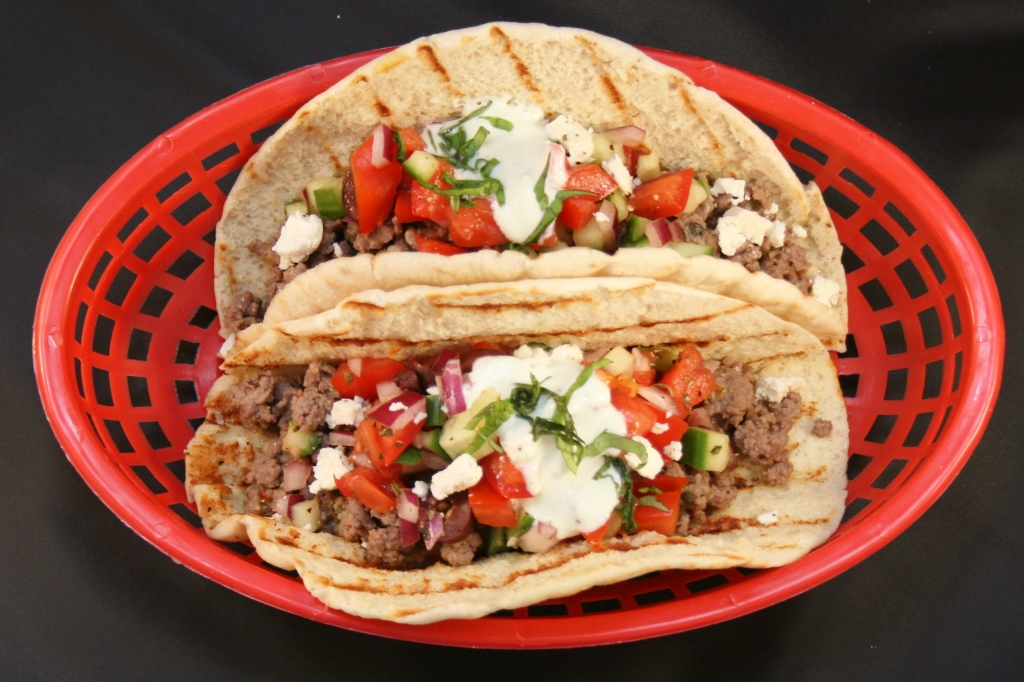Gyro’s Gone Wild
aka; The Big Greek Taco
If you’re like me, you could put tzatziki sauce and feta cheese on everything. And what smells and tastes better than seasoned meat grilling on a stick? Why eat bread when you can slather olive oil on pita bread and lightly grill it? Even better, combine all of the above with a tomato, Kalamata olive and cucumber salsa, and some thinly sliced pickled red onion and it’s on! GYRO TIME!
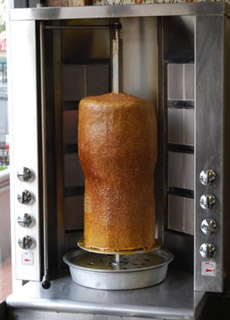 The gyros we get in a restaurant are either those large, inverted cones of meat on a spit or, layers of thinly sliced, seasoned meat (usually beef and lamb) alternated in layers on a spit. The cone process starts with boxes of raw beef and lamb trimmings, and ends with what looks like oversized Popsicles the shade of a Band-Aid. In between, the meat is run through grinder, where bread crumbs, water, oregano and other seasonings are added. A clumpy paste emerges and is squeezed into a machine that checks for metal and bone. Hydraulic pressure — 60 pounds per square inch — is used to fuse the meat into cylinders, which are stacked on trays and then rolled into a flash freezer, where the temperature is -20.
The gyros we get in a restaurant are either those large, inverted cones of meat on a spit or, layers of thinly sliced, seasoned meat (usually beef and lamb) alternated in layers on a spit. The cone process starts with boxes of raw beef and lamb trimmings, and ends with what looks like oversized Popsicles the shade of a Band-Aid. In between, the meat is run through grinder, where bread crumbs, water, oregano and other seasonings are added. A clumpy paste emerges and is squeezed into a machine that checks for metal and bone. Hydraulic pressure — 60 pounds per square inch — is used to fuse the meat into cylinders, which are stacked on trays and then rolled into a flash freezer, where the temperature is -20.
Gyros are believed to have originated in Greece. (They’re similar to the döner kebabs of Turkey and shawarma of the Middle East, which are slices of meat, rather than a minced loaf.) But they were never mass produced in Europe. Until the early 1970s, the cones were made one at a time, in restaurant kitchens using family recipes. These cones are extremely popular in large, culturally diverse cities in the East, like Chicago, New York and Boston.
Since we will be cooking these at home, and we don’t have a hydraulic meat squeezer or a walk in -20° flash freezer, let’s look at a couple ways to cook these in our own kitchens. There are some tricks I will share with you to get that restaurant quality flavor from a family-style recipe. The first hurdle to overcome is what kind of cooking device or vessel to use. If you’re going to go vertical spit there are a couple of options for you, some costing from several hundred dollars to a couple of thousand, or the countertop variety like the iconic Showtime Rotisserie, made popular by the phrase “Set it, and forget it!” Personally I don’t want another device cluttering up my countertops, but that’s up to you. The third option is ridiculously inexpensive, and is what I use for not only gyros, but tacos Al Pastore and roasted chicken. Here’s a picture of my vertical spit. It doesn’t rotate, nor does it have its own heat source, but you can set it in the oven or on the barbecue and give it a spin every once in a while. It works great, saves money and countertop space, and it looks cool when you’re slicing delicious meat from it. The last option is to cook it just like you would cook a meatloaf and serve slices exactly as if it had come off the spit.
It doesn’t rotate, nor does it have its own heat source, but you can set it in the oven or on the barbecue and give it a spin every once in a while. It works great, saves money and countertop space, and it looks cool when you’re slicing delicious meat from it. The last option is to cook it just like you would cook a meatloaf and serve slices exactly as if it had come off the spit.
My Greek Taco recipe that follows is not a traditional Greek Gyro, but rather something I came up with probably at 3 in the morning not long ago when my brain was running in overdrive. The results were amazing. The packaged seasoning mix was fast, easy and imparted tons of flavor.
Preparation 1: Greek Tacos
2 pounds ground beef
2 pounds ground lamb
1 pound fresh Italian pork sausage
4 to 6 cloves fresh minced garlic
4 tablespoons dried oregano
Two packages of Italian salad dressing mix
Salt and pepper to taste
6-8 ripe Roma tomatoes diced (or other)
1 large cucumber diced
½ cup pitted Kalamata olives rough chopped
Juice of ½ lemon
8 oz Greek Yogurt
3 or 4 sprigs of dill chopped
3 oz. good quality Feta cheese
2 packages of Original style pita bread
In a large bowl, combine the first seven ingredients with your hands making sure to get all the seasonings evenly dispersed throughout the meat. Form the meat into patties that are no larger than the base of your spit. This will keep your meat uniform and prevent uneven cooking. If your spit doesn’t have a flat base, pierce an aluminum pie pan with the top of the spit and slide it, upside down, all the way to the bottom of the spit. Instant base. I set mine in an aluminum roasting pan to catch the drippings. Optionally, this can all be done as a meatloaf, in an appropriate pan.
Preheat your oven or grill to 400 degrees. Cook until the center reaches 160 degrees. (165 is the safe temp for ground meat but the carryover heat will continue to cook to 165). As the meat cooks it will begin to darken (caramelize). Simply give the pan a spin as necessary to brown all sides evenly. If your Gyro exterior is getting done to fast simply trim the done pieces and let fall into the roasting pan and grab them up with some bbq tongs.
Carefully slice the pita bread horizontally to make 24 thin pita taco shells. Cautionary note here; make sure the pita’s you but are not crumbly and flat. They should be somewhat puffy which will make them easier to cut and separate. Brush them with olive oil and grill them quickly so they remain pliable and not crispy.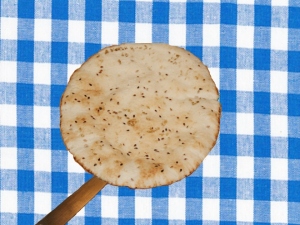
When the meat is done, you can slice it off the spit into the delicious drippings, or lift it out and slice onto a cutting board or serving tray. Either way you will want to serve it taco style as follows (because here in California you can get anything in a taco).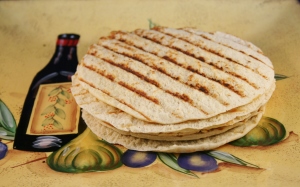 For the salsa;
For the salsa;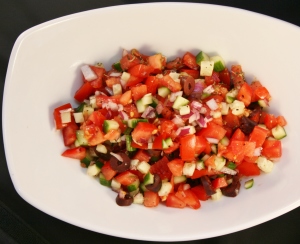
Combine half of the diced cucumber with all of the diced tomatoes, the Kalamata olives and one sprig of dill. Salt and pepper to taste.
For the Tzatziki;
Combine the rest of the cucumber with the dill, lemon juice and yogurt in a food processor or blender. Depending on how watery your cucumber is you may want to squeeze it dry with a kitchen towel or your sauce will become very thin. Purée the mixture until it is smooth. Pour into a container and store in the refrigerator for at least an hour prior to using. Add salt and pepper to taste.
Place the meat in the grilled pita bread, top it with the salsa, a spoonful of the sauce and some feta cheese. There you have it the perfect Greek taco.
Enjoy
RTK

